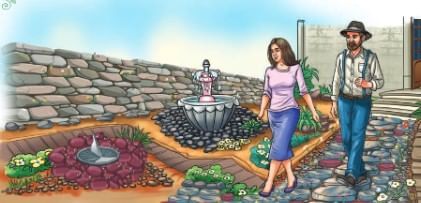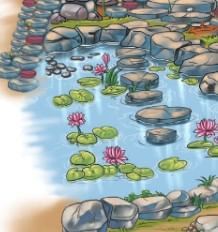Very Short Answer Questions: A Concrete Example | English Poorvi Class 8 - New NCERT PDF Download
Q1. Who is the poet of "A Concrete Example"?
Ans: The poet of "A Concrete Example" is Reginald Arkell.
Q2. What is the primary feature of Mrs. Jones’s garden described in the poem?
Ans: The primary feature of Mrs. Jones’s garden is a collection of stones, including a crazy path, rockery, and sundial.

Q3. How many stanzas does the poem "A Concrete Example" have?
Ans: The poem has three stanzas.
Q4. How does the poem’s language create its overall mood?
Ans: The poem’s light-hearted and humorous language creates a whimsical and slightly amused mood.
Q5. What feature of Mrs. Jones’s garden is described as winding?
Ans: The crazy path in her garden is winding.
Q6. What is the name of the water feature in Mrs. Jones’s garden?
Ans: The water feature is a lily pond.
Q7. What is a rockery in Mrs. Jones’s garden?
Ans: A rockery is a decorative arrangement of stones.
Q8. What device in the garden tells time using the sun?
Ans: The sundial tells time using the sun.
Q9. How does Mrs. Jones feel about her sundial’s design?
Ans: Mrs. Jones thinks the sundial’s design is rather nice.
Q10. What does Mrs. Jones place between the stones in her garden?
Ans: She places tiny plants between the stones.
Q11. How does the speaker describe the plants in the garden?
Ans: The speaker describes the plants as delicate and small.
Q12. How does the speaker view the significance of the tiny plants?
Ans: The speaker views the tiny plants as having no significant value.

Q13. What tool does the speaker humorously suggest Mrs. Jones uses to plant?
Ans: The speaker suggests she uses a pin to plant the tiny plants.
Q14. What does Mrs. Jones invite the speaker to see in her garden?
Ans: She invites the speaker to see her stones.
Q15. How long do the speaker and Mrs. Jones talk about a flower?
Ans: They talk about a flower for a quarter of an hour.
Q16. What surprising thing does Mrs. Jones say about the flower?
Ans: She says the speaker is standing on the flower.
Q17. What does the speaker’s mistake of stepping on the flower create?
Ans: The mistake creates a humorous and ironic moment.
Q18. What does Mrs. Jones’s garden reveal about her character?
Ans: Her garden reveals her eccentric character, with a preference for stones over typical plants.
Q19. What does the poem suggest about beauty through Mrs. Jones’s garden?
Ans: The poem suggests beauty can be found in unexpected places.
Q20. What does the speaker’s view of the plants show about perception?
Ans: The speaker’s view that the plants are insignificant shows perception differs from reality.
|
58 videos|435 docs|57 tests
|
FAQs on Very Short Answer Questions: A Concrete Example - English Poorvi Class 8 - New NCERT
| 1. What is concrete and what are its main components? |  |
| 2. How is concrete made and what are the steps involved in the mixing process? |  |
| 3. What are the different types of concrete used in construction? |  |
| 4. What are some common uses of concrete in construction? |  |
| 5. How does weather affect the curing process of concrete? |  |
















